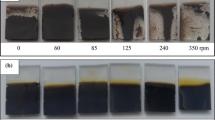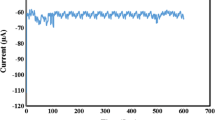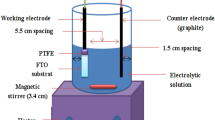Abstract
Cadmium sulfide (CdS) is a well-known window material used for fabrication of second generation thin film solar cells including CdS/CdTe and CdS/CuInGaSe2. Among the CdS fabrication techniques, electrodeposition is a simple, cost effective and scalable method that has been stepped towards large scale commercialization. However, the presence of precipitates in baths used for electrodeposition of CdS has been found to be a persistent problem which had produced CdS thin films with poor photovoltaic properties. Hence, an investigation was carried out to identify a set of optimum physiochemical conditions that can produce clear stable electrolyte for electrodeposition of CdS thin film semiconductors using CdCl2 and Na2S2O3 precursor salts. The study revealed that, electrolytes containing 0.10 mol/L CdCl2 and 0.01 mol/L Na2S2O3, within the pH range of 1.50–2.00 and the temperature range of 55–65 °C can provide clear and stable electrolytes for electrodeposition of CdS thin films. Further, the results showed that, the electrical, optical, morphological and structural properties of CdS layers electrodeposited from electrolytes within above physiochemical conditions were remarkably better to those electrodeposited from the turbid electrolytic baths formed beyond the ranges of predetermined optimum physiochemical conditions.









Similar content being viewed by others
References
V. Plotnikov, Fabrication of Ultra Thin CdS/CdTe solar cells by magnetron sputtering, The University of Toledo, 2009
U. Madhu, N. Mukherjee, N.R. Bandyopadhyay, A. Mondal, Properties of CdS and CdTe thin films deposited by an electrochemical technique. Indian J. Pure Appl. Phys. 45, 226 (2007)
I.M. Dharmadasa, P. Bingham, O. Echendu, H. Salim, T. Druffel, R. Dharmadasa, G. Sumanasekera, R. Dharmasena, M. Dergacheva, K. Mit, K. Urazov, L. Bowen, M. Walls, A. Abbas, Fabrication of CdS/CdTe-based thin film solar cells using an electrochemical technique. Coatings 4, 380–415 (2014)
M.N. Mammadov, A. Sh Aliyev, M. Elrouby, Electrodeposition of cadmium sulfide. Int. J. Thin Film Sci. Tec. 1(2), 43–53 (2012)
K. Zarȩbska, M. Skompska, Electrodeposition of CdS from acidic aqueous thiosulfate solution-invesitigation of the mechanism by electrochemical quartz microbalance technique. Electrochim. Acta 56(16), 5731–5739 (2011)
J. Nishino, S. Chatani, Y. Uotani, Y. Nosaka, Electrodeposition method for controlled formation of CdS films from aqueous solutions. J. Electroanal. Chem. 473(1), 217–222 (1999)
C.M.A. Brett, A.M.O. Brett, Electrochemistry; Principles,(Oxford University Press, Oxford, 1993)
M. Cao, Y. Sun, J. Wu, X. Chen, N. Dai, Effects of cadmium salts on the structure, morphology and optical properties of acidic chemical bath deposited CdS thin films. J. Alloys Compd. 508(2), 297–300 (2010)
S.G. Kumar, K.S.R.K. Rao, Physics and chemistry of CdTe/CdS thin film heterojunction photovoltaic devices: fundamental and critical aspects. Energy Environ. Sci. 7(1), 45 (2014)
N.A. Abdul-Manaf, A.R. Weerasinghe, O.K. Echendu, I.M. Dharmadasa, Electro-plating and characterisation of cadmium sulphide thin films using ammonium thiosulphate as the sulphur source. J. Mater. Sci. 26(4), 2418–2429 (2015)
K.A.M.H. Siddiquee, M.A.K. Pathan, S. Alam, O. Islam, M.R. Qadir, Investigation of CdS and CdTe thin films and influence of CdCl2 on CdTe/CdS structure. Optik (Stuttg) 124(20), 4383–4388 (2013)
M. Fathy, A.E.B. Kashyout, S. Elyamny, G.D. Roston, Effect of CdCl2 concentration and heat treatment on electrodeposited nano-crystalline CdS thin films from non- aqueous solution. 9, 6155–6165 (2014)
H.Y.R. Atapattu, D.S.M. De Silva, K.A.S. Pathiratne, I.M. Dharmadasa, Effect of stirring rate of electrolyte on properties of electrodeposited CdS layers. J. Mater. Sci. 27(5), 5415–5421 (2016)
J.M. Nel, H.L. Gaigher, F.D. Auret, Microstructures of electrodeposited CdS layers. Thin Solid Films 436(2), 186–195 (2003)
A. Cortes, Grain size dependence of the bandgap in chemical bath deposited CdS thin films. Sol. Energy Mater. Sol. Cells 82(1–2) 21–34 (2004)
A. Romeo, D.L. Bätzner, H. Zogg, C. Vignali, A.N. Tiwari, Influence of CdS growth process on structural and photovoltaic properties of CdTe/CdS solar cells. Sol. Energy Mater. Sol. Cells 67, (1–4) 311–321 (2001)
N. Romeo, A. Bosio, R. Tedeschi, V. Canevari, Growth of polycrystalline CdS and CdTe thin layers for high efficiency thin film solar cells. Mater. Chem. Phys. 66(2–3), 201–206, (2000)
J. Toušková, D. Kindl, J. Toušek, Preparation and characterization of CdS/CdTe thin film solar cells.” Thin Solid Films 293(1–2), 272–276 (1997)
S. Alam, M.A.K. Pathan, K.A.M.H. Siddiquee, a..B.M.O. Islam, M.a.. Gafur, D.K. Saha, M. Mori, T. Tambo, Optical and structural characterization of CdSe and CdTe layers and fabrication of a CdTe/CdSe structure.” Optik (Stuttg) 124(15), 2165–2170 (2013)
D.G. Diso, Dissertation, Research and development of CdTe based thin film PV solar cells, 2011
Acknowledgements
Authors acknowledge the University Grants Commission, Sri Lanka and National Research Council, Sri Lanka for the financial support under the UGC Innovative Research Grant and the NRC Grant 06-60 respectively.
Author information
Authors and Affiliations
Corresponding author
Rights and permissions
About this article
Cite this article
Atapattu, H.Y.R., De Silva, D.S.M., Pathiratne, K.A.S. et al. Necessity and relevance of precipitate free clear electrolytes for electrodeposition of CdS semiconductor materials with enhanced photovoltaic properties. J Mater Sci: Mater Electron 28, 18592–18602 (2017). https://doi.org/10.1007/s10854-017-7808-3
Received:
Accepted:
Published:
Issue Date:
DOI: https://doi.org/10.1007/s10854-017-7808-3




